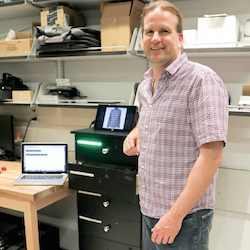
A “smart” dresser that has been tested in the lab ultimately could help people with dementia get dressed with automated help and nobody else in the same room.
“Our goal is to provide assistance for people with dementia to help them age in place more gracefully, while ideally giving the caregiver a break as the person dresses —with the assurance that the system will alert them when the dressing process is completed or prompt them if intervention is needed,” Winslow Burleson, Ph.D., said.
Burleson, an associate professor at the New York University Rory Meyers College of Nursing, is the lead author of a new study of the technology published in the journal JMIR Medical Informatics. The researchers said the system could be helpful in residential care settings as well as in homes.
The prototype of the dressing system, named DRESS, includes a dresser, a tablet computer, sensors and a camera to track the progress of the person with dementia while he or she is dressing.
One piece of clothing is placed in each of the dresser’s five drawers in an order that follows the user’s dressing preferences. The pieces of clothing have barcodes on them to help the camera, on top of the dresser, identify their type, location and orientation. The person with dementia wears a skin-conductance sensor like a bracelet, and the sensor monitors indicators of his or her stress level.
The caregiver starts and monitors the progress of the DRESS system using an app. The person with dementia receives an audio prompt, recorded in the caregiver’s voice, to open the top drawer, which lights up at the same time.
If an item of clothing is put on correctly, then the DRESS system prompts the user to proceed to the next drawer. If the system detects an error or lack of activity, then audio prompts are used to correct and encourage the user. If it detects ongoing issues or an increase in stress levels, then the system can alert a caregiver that help is needed.
When researchers used cognitively healthy study participants to test the prototype’s ability to accurately detect proper dressing, they found that the system was able to detect clothing orientation and position as well as infer someone’s current state of dressing.
In initial phases, when study participants put on shirts or pants, the DRESS prototype accurately detected their clothing 384 of 388 times. The prototype was not able to consistently identify when someone finished putting on a piece of clothing, however, missing the final cues in 10 of 22 cases for shirts and five of 22 cases for pants.
Based on their findings, the researchers plan to increase the size of the barcodes and minimize garment-folding that might prevent the camera from reading the barcodes.
The researchers also plan to test the dressing system in homes. “We will pay particular attention to determining how the DRESS prototype prompts and the diverse nature of individuals’ home environments might alter the detecting process and results,” they wrote.
They also plan to conduct cost-benefit analyses to determine the economic value of the system. If $20 per day represents the combined value of increased independence for people with dementia and reduced stress and effort needed for caregivers, the researchers said, then a system cost of $1,200 to $2,000 could be recouped in two to four months.
“Subscription plans rather than purchase might also make such systems broadly affordable,” they said.



